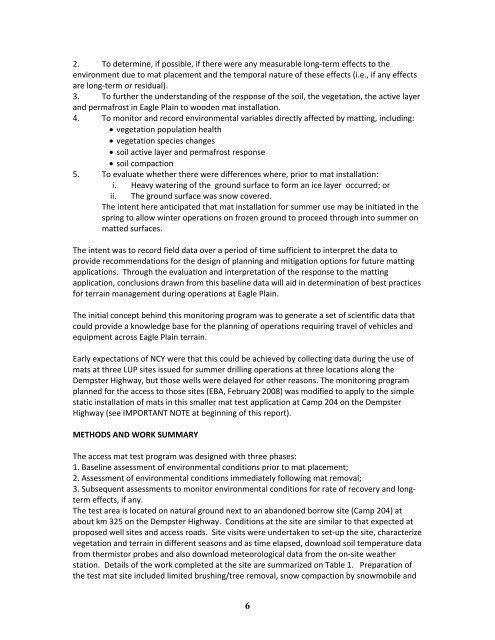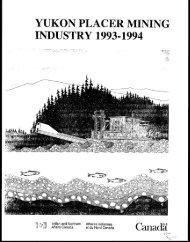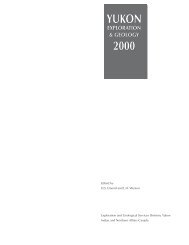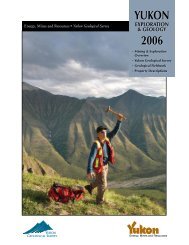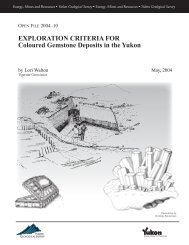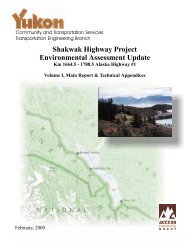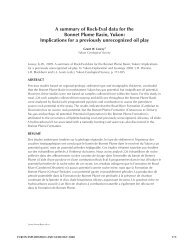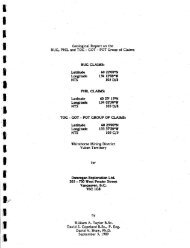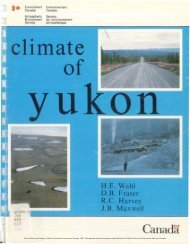Eagle_Plain_matting_..
Eagle_Plain_matting_..
Eagle_Plain_matting_..
Create successful ePaper yourself
Turn your PDF publications into a flip-book with our unique Google optimized e-Paper software.
2. To determine, if possible, if there were any measurable long‐term effects to the<br />
environment due to mat placement and the temporal nature of these effects (i.e., if any effects<br />
are long‐term or residual).<br />
3. To further the understanding of the response of the soil, the vegetation, the active layer<br />
and permafrost in <strong>Eagle</strong> <strong>Plain</strong> to wooden mat installation.<br />
4. To monitor and record environmental variables directly affected by <strong>matting</strong>, including:<br />
• vegetation population health<br />
• vegetation species changes<br />
• soil active layer and permafrost response<br />
• soil compaction<br />
5. To evaluate whether there were differences where, prior to mat installation:<br />
i. Heavy watering of the ground surface to form an ice layer occurred; or<br />
ii. The ground surface was snow covered.<br />
The intent here anticipated that mat installation for summer use may be initiated in the<br />
spring to allow winter operations on frozen ground to proceed through into summer on<br />
matted surfaces.<br />
The intent was to record field data over a period of time sufficient to interpret the data to<br />
provide recommendations for the design of planning and mitigation options for future <strong>matting</strong><br />
applications. Through the evaluation and interpretation of the response to the <strong>matting</strong><br />
application, conclusions drawn from this baseline data will aid in determination of best practices<br />
for terrain management during operations at <strong>Eagle</strong> <strong>Plain</strong>.<br />
The initial concept behind this monitoring program was to generate a set of scientific data that<br />
could provide a knowledge base for the planning of operations requiring travel of vehicles and<br />
equipment across <strong>Eagle</strong> <strong>Plain</strong> terrain.<br />
Early expectations of NCY were that this could be achieved by collecting data during the use of<br />
mats at three LUP sites issued for summer drilling operations at three locations along the<br />
Dempster Highway, but those wells were delayed for other reasons. The monitoring program<br />
planned for the access to those sites (EBA, February 2008) was modified to apply to the simple<br />
static installation of mats in this smaller mat test application at Camp 204 on the Dempster<br />
Highway (see IMPORTANT NOTE at beginning of this report).<br />
METHODS AND WORK SUMMARY<br />
The access mat test program was designed with three phases:<br />
1. Baseline assessment of environmental conditions prior to mat placement;<br />
2. Assessment of environmental conditions immediately following mat removal;<br />
3. Subsequent assessments to monitor environmental conditions for rate of recovery and long‐<br />
term effects, if any.<br />
The test area is located on natural ground next to an abandoned borrow site (Camp 204) at<br />
about km 325 on the Dempster Highway. Conditions at the site are similar to that expected at<br />
proposed well sites and access roads. Site visits were undertaken to set‐up the site, characterize<br />
vegetation and terrain in different seasons and as time elapsed, download soil temperature data<br />
from thermistor probes and also download meteorological data from the on‐site weather<br />
station. Details of the work completed at the site are summarized on Table 1. Preparation of<br />
the test mat site included limited brushing/tree removal, snow compaction by snowmobile and<br />
6


